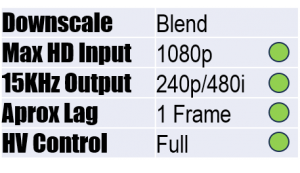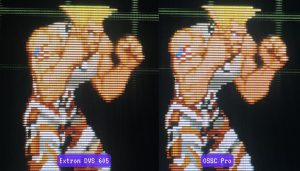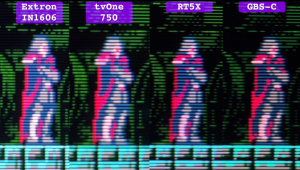Extron DVS 605 Part 3
Extron DVS 605 (Part 2)
Extron IN1606 (Part 1)
Setup required: Download the PCS software to upload a custom 240p EDID.bin (links below)
Availability: Second-hand online, can be found cheap
The Extron IN1606, DVS 605 and DSC 301 HD are 3 of several scalers on the Product Configuration Software (PCS) list that can output 240p using a custom EDID.bin file. To upload an EDID file, use the PCS program using the provided link which does not require a sign in (FW 4.7.1): https://www.dimedtec.de/downloads/Extron/PCS/
In my first attempt at creating a 240p EDID, the vertical frequency was sub-60Hz and caused noticeable frame skips. However, there is a pre-made 240p EDID for RGB output thanks to Filthy Pants, which should output 60Hz. Altering or creating a fresh EDID file will require a third party program or the official Extron EDID Manager.
Front and back of the DVS 605 A
The DVS 605 is versatile for downscaling all video sources, with 3 HDMI inputs, 2 DE15 connectors which can accept composite, S-Video, component, and RGB. Analog RGB or component can output via DE15, and there is a digital output via HDMI for simultaneous downscaling. Keep in mind that I could only get the HDMI output to sync to a CRT if I ran the output of an external DAC through an Extron RGB interface, and that even the DVS 605’s may require an Extron RGB Interface to output legible sync. The IN1606/1608 has the same inputs as the DVS 605, but as it only has HDMI output, it will require a DAC and RGB interface. It is worth noting that the IN1606 could not output 480i without significant horizontal jitter on a BVM D20F1 (DAC required), but worked on a JVC DT-V1710CG. Also worth noting for the DVS 605
The DVS 605 is very flexible with input resolutions up to 1080p, and can output 240p and 480i. On the DVS 605 with AFL turned on, progressive inputs have 17msec (1 frame) of lag, and 33msec (2 frames) for interlaced (thanks to ShankMods for pointing this out). In contrast, the IN1606 only has 0.2-1.3 frames of lag for progressive inputs and 1.25-2.25 frames when downscaling 480i sources.
Blending vertical lines with a fine balance of sharpness and detail helps mitigate vertical shimmer for non-240p 2D pixel art, reduces jaggy outlines of linear and 3D geometric shapes, and can restore 240p on-par with a line decimator like the OSSC Pro. It also surpasses the Corio2 tvONE 750 for image clarity and picture controls, with fluid HV positioning and image presets/recall function.
In summary, the Extron EDID Method of downscaling can be a viable option for anyone with a compatible scaler, provided a link to the PCS software remains available which does not require a login. I recommend the DVS 605 as a 240p/480i downscaling powerhouse.
Verdict: Recommended



